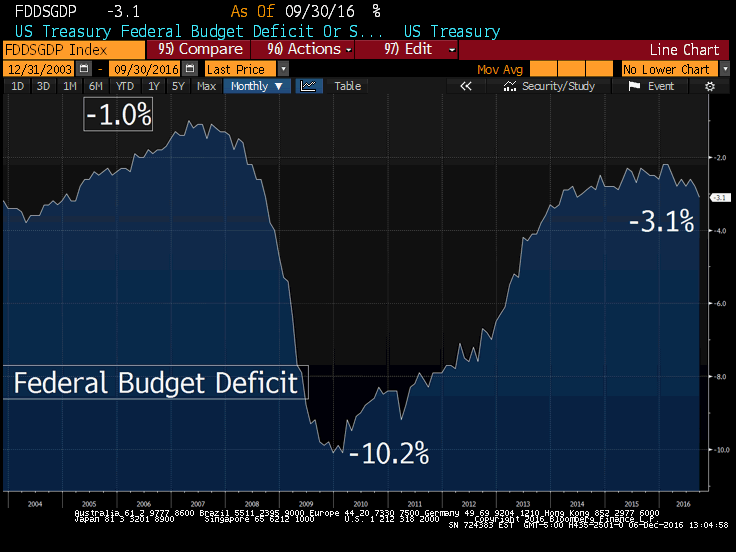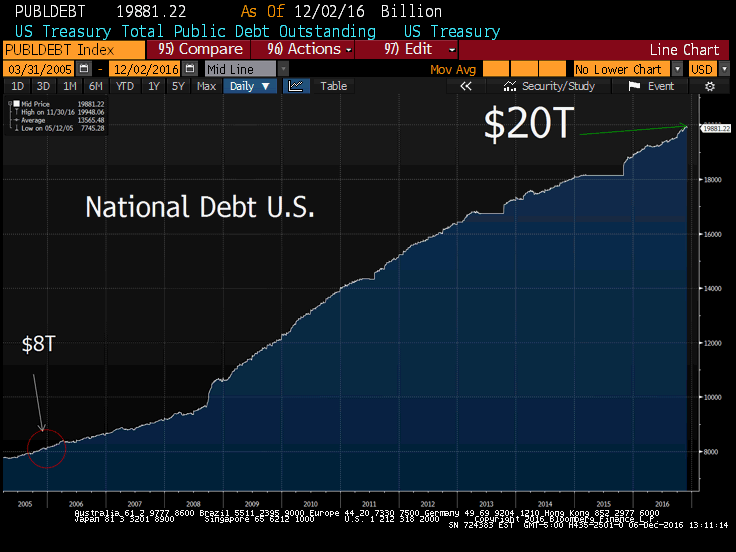Breaking: Third Quarter GDP in at 3.5%
Annual GDP growing 1.9%
Q4: 2.6%*
Q3: 3.5%
Q2: 1.4%
Q1: 0.9%
*Per Atlanta Fed from Dec 16, 2016
Where are bond yields going with debt on the rise? Click here for our latest report.
Yesterday, the lame duck Congress was able to avoid the annual government shutdown risk surge, there were less games – more action. Ultimately, the big showdown is next year at the start of Donald Trump’s presidency.
Trump Tax and Foreign Policy: Winners and Losers
Stocks, Bonds, Currencies and Commodities Since the Election*
Russell: 21%
Russia: 18%
Brent: 17%
Copper: 14%
Mexico: 8%
S&P 500: 8%
EuroStoxx 600: 6%
Brazil: 5%
Nasdaq 100: 5%
Emerging Markets: 5%
China: 4%
Dollar DXY: +4%
FANG Stocks: 0%
Treasuries: +65bps in yield, US 10 year
Gold: -9%
*Bloomberg data, from the November lows near election day, FANG = Facebook, Amazon, Netflix, Google
*SENATE PASSES STOPGAP U.S. SPENDING BILL, AVERTS FUNDING LAPSE
The Senate passed 63 to 36 a stopgap spending bill, funding the government through April 28, averting a shutdown but putting off a long list of decisions on bills to finance the rest of the fiscal year through October.
That lawmakers are heading toward a potentially time-consuming fight over spending in the spring that could test the limits of newfound Republican unity with Trump and eat up valuable time, delaying other legislative priorities.
Don’t miss our next trade idea. Get on the Bear Traps Report Today, click hereClick here for our latest report.
Today’s Federal Budget Deficit is Substantially Greater than those Found in the Bush and Clinton Economic Recoveries

The deficit as percentage of GDP has come down considerably over the Obama years. Of course, when Obama took over the White House the economy was in a recession. Naturally government deficits rise and GDP falls in economic downturns, which makes this number more negative (-10.2% in 2009 above). However, over the Obama years deficits have been lower as the recovery took hold. Trump and his aggressive pro-growth plans will likely reverse that trend, until the growth follow through offsets it. We’ll see a return to supply side economics in the years to come, Trump wants to use tax cuts to stimulate growth.
Percentage of US Government spending on entitlements and debt
interest payments:
2015: 71%
1965: 26%
CBO
In 8 years of the Obama administration, the U.S. didn’t achieve one year of year over year +3% growth. That has not happened in nearly 100 years.
U.S. Real Year over Year Annual GDP
2016: 1.8%
2015: 2.6%
2014: 2.4%
2013: 1.7%
2012: 2.2%
2011: 1.6%
2010: 2.5%
2009: -2.8%
2008: -0.3%
2007: 1.8%
2006: 2.7%
2005: 3.3%
2004: 3.8%
2003: 2.8%
2002: 1.8%
2001: 1.0%
2000: 4.1%
1999: 4.7%
1998: 4.5%
1997: 4.5%
1996: 3.8%
1995: 2.7%
1994: 4.0%
1993: 2.7%
1992: 3.6%
- Above 3% year over year growth is in blue
Bloomberg, CBO data
Don’t miss our next trade idea. Get on the Bear Traps Report Today, click hereWhere are bond yields going with debt on the rise? Click here for our latest report.
 The Trump administration and Congress of 2017 have a colossal collection of goals for their first 100 days; a) filing and (Congress) approving Cabinet posts, b) a Supreme Court vacancy, c) corporate and individual tax reform, d) replace and repeal of Obamacare and reversing a long list of regulations issued by the outgoing Obama administration in its final months. Adding the need to fund the entire federal government makes all of those objectives even more difficult. As you can see above, the Federal deficit is near unsustainable proportions. The U.S. needs far more than 1.7% GDP growth to support this debt load.
The Trump administration and Congress of 2017 have a colossal collection of goals for their first 100 days; a) filing and (Congress) approving Cabinet posts, b) a Supreme Court vacancy, c) corporate and individual tax reform, d) replace and repeal of Obamacare and reversing a long list of regulations issued by the outgoing Obama administration in its final months. Adding the need to fund the entire federal government makes all of those objectives even more difficult. As you can see above, the Federal deficit is near unsustainable proportions. The U.S. needs far more than 1.7% GDP growth to support this debt load.
U.S. Federal Spending as a % of GDP
16: 35%
10: 33%
00: 29%
90: 32%
80: 30%
70: 29%
60: 23%
50: 19%
40: 14%
Arthur Brooks, CBO, Treasury data
“The Federal Reserve’s decision to raise interest rates is a warning sign to government budget watchers. The combination of rising debt levels and rates will lead to soaring interest payments, putting a strain on U.S. purse strings. A measure known as net interest costs — which balances what the government receives in interest payments against what it pays on debt — is already set to nearly triple by 2026, to $712 billion, or 2.6 percent of gross domestic product, according to the Congressional Budget Office forecasts from August. That figure soars to nearly 6 percent of GDP by 2056.”
Bloomberg, December 2016
Tax Reform and Side Effects
Front and center, corporate tax reform tied to infrastructure, will be priority number one in our view. The prospect of tax reform and a lower rate have already played a big role in equity market returns. The Russell 2000 is up 17% year-to-date and 11% since the election. The S&P 500 is only up 8% year-to-date and 3.1% since the election. Many mega-cap S&P companies have already used tax shelters such as Ireland, which has a corporate tax rate of 12.5% (vs 38% in the U.S.). The market is now rewarding companies who will see the biggest nominal effective change in the reduction of their corporate tax rate.
FANG stocks, who have been famous for using other countries as a base in order to pay less in taxes, have been punished relative to domestic retailers and energy companies who have very high effective tax rates.
See the report below, click on the link.
Don’t miss our next trade idea. Get on the Bear Traps Report Today, click hereClick here for our latest report.


